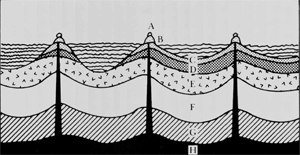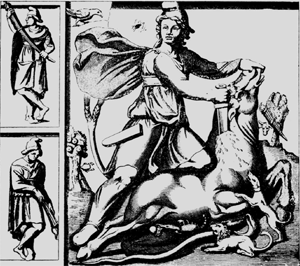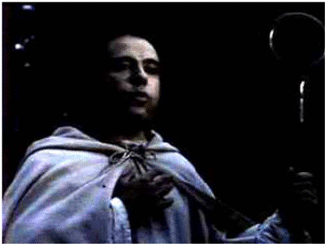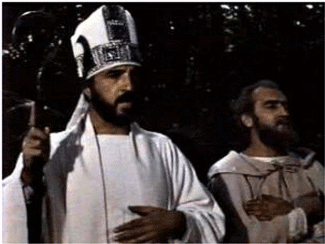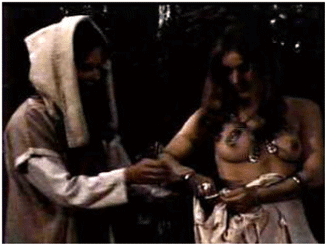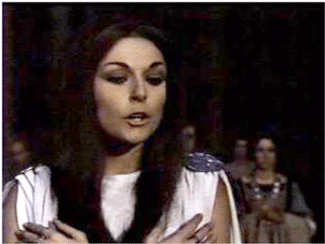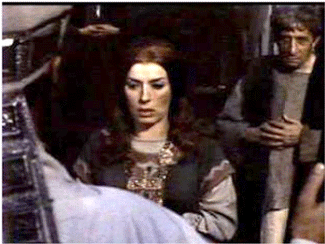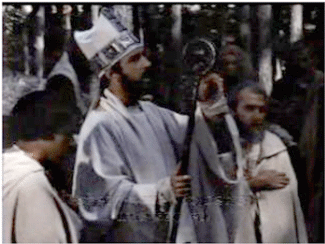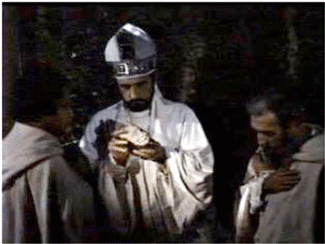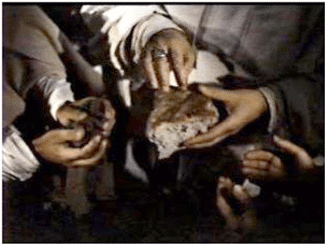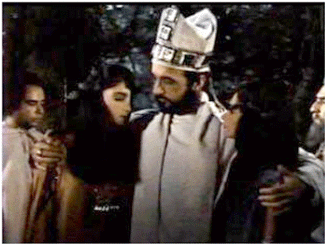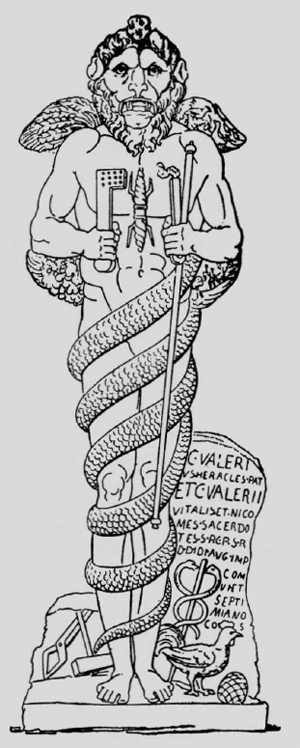CHAPTER FIVE: Volkisch Utopianism and Sun Worship
NINETEENTH-CENTURY Europe witnessed a revival of what has been termed volkisch ("folkish") movements, nationalistic groups bonded together by a common ethnic and cultural identity (the idea of Volk) and seeking a political and cultural return to an idealized past or golden age. A new utopian golden age of the Volk could then be established. Heredity became infused with social and political aims, and supported by "scientific" medical and psychiatric theories of hereditary degeneration. Many volkisch groups -- especially Pan-German and Pan-Slavic groups -- elevated notions of racial purity to a quasi-scientific, quasi-mystical ideal. Although Zionism is essentially a volkisch movement, as historians such as Carl Schorske have pointed out, it is primarily the Pan-Germanic movement of the nineteenth century that is meant by the term volkisch or Volkstumbewegung ("volkisch movement").
On and off since the sixteenth century wistful reference has been made to "the old Teutons" that are the mythic ancestors of ethnic German peoples. As with most national myths, very little in fact is known about the beliefs and actions of the actual Teutonic or Germanic tribes of pagan Europe. Most of the information upon which such fantasies are based comes from an ancient Roman source: the Germania by Tacitus. Historian Ekkehard Hieronimus has summarized the interest in Germanic religion since the recording of Germanic sagas and myths by Snorri Sturulson (1179-1241) until what he claims is the "late" (nineteenth-century) interest of German scholars in the history, life, and thought of the German Volk due to the "strong fixation of historians on the Greco-Roman area as the only world of culture." [1] Such nineteenth-century research on the Germans, Hieronimus argues, was adopted by neopagan groups devoted to reexperiencing the Germanic mysteries. Indeed, a return to the golden age and "natural" life of the Teutons has frequently been invoked by German groups appealing to renewal or rebirth.
In Germany and Switzerland, the Pietist movement in the early eighteenth century used such volkisch appeals in its efforts to revive religion by fashioning a specifically German brand of Protestantism. By the mid-1700s, according to Hermand, it was "often difficult to distinguish between the concepts of an 'inner' and an 'outer' fatherland in Pietist writings." [2] Furthermore, "in these circles the secularization of a number of bourgeois/protestant concepts such as the family, the community, and the notion of a sacrificial death was characterized by an increasing patriotism which drew parallels between Christ's martyrdom and the martyrdom of national heroes like Siegfried or Arminius." [3] These very same themes of sacrificial death and the identification of the Christian god with the Teutonic god would resurface prominently two centuries later in a signal work by a descendant of German Protestant pietists -- Jung's noted Wandlungen und Symbole der Libido (1912). [4]
In the 1800s, the idea of uniting the dozens of German principalities and other political units was based on an appeal to reunite and revive the ancient Volk. Pan-Germanism spread throughout all the traditionally Germ.an areas as well as throughout Austria-Hungary and even in Switzerland. Before Pan-Germanism developed into a predominantly anti-Semitic movement at the end of the century, many secular Jews seeking greater political influence through more thorough assimilation into Christian circles (rather than further segregation through Reform Judaism) participated in Pan-Germanic activities. The young Freud was such a person, briefly caught up in Pan-Germanism during his student years. However, his experience with anti-Semitism during this time "put an end forever to the phase of German nationalistic enthusiasm through which he passed in early years." [5]
By the fin de siecle, small German volkisch groups, influenced in no small part by the occult revival of the nineteenth century, began forming throughout Germany and Austria-Hungary, and especially in Switzerland. Germanic seekers of renewal and rebirth who had perhaps started out in spiritualism or Theosophy began to become attracted to philosophies based on more mundane nationalistic, hereditarian, or anti-Semitic principles of renovatio. Thus, as in the case of the prominent Viennese occultist Friedrich Eckstein (1861-1939), participation in a Wagnerian Bund led to further metamorphoses into spiritualism and Theosophy. [6] Eckstein was the founder of the prominent Vienna Theosophical Society in 1886 and was a close associate of composers Anton Bruckner and Gustav Mahler, Viktor Adler (leader of the Austrian socialists), Franz Hartmann (a prominent Theosophist), and Steiner.
It was not long before volkisch groups began to adopt the methods of spiritualism and Theosophy to seek rebirth. Such an evolution seemed natural:
The uses of theosophy for political purposes consisted in its universal and non-Christian perspective upon the cosmos, against which the sources of Teutonic belief, customs and folk-identity could be located. Indeed the very structure of theosophical doctrine lent itself to volkische thought. The implicit elitism of the mahatmas with superhuman wisdom corresponded to the whimsies of a master race; the notion of an occult gnosis in theosophy, notably its obscuration by Christian orthodoxy, accorded with the attempts to ascribe a long pedigree to German volkische nationalism, especially in view of its really recent origins. [7]
Circa 1900 volkisch groups that promised direct initiations into the mysteries of the ancient Teutonic tribes began to appear. Admittedly, most of these neopagan groups were rather fluid and left little recorded history, but as Hermand notes, this period was clearly marked "by a veritable deluge of the most diverse groups, parties, fraternities, and lodges" in which it is apparent that "the politically immature bourgeoisie has become intoxicated with Teutonism." [8] The innumerable pamphlets and booklets of volkisch groups have been lost to us as the ephemera or "fragments of a faith forgotten," but some scholars have devoted attention to what little remains. [9]
Common characteristics across many of these groups seem to have included the following: a rejection of Christianity in favor of a mystical Volk connection with the ancient Aryan peoples (especially the Teutons); nature-worship, hiking, and nudism; [10] neopagan rituals (dancing around bonfires, magical ceremonies invoking the Norse -- and sometimes Greek -- gods); the study of the Aryan roots of occult symbolism (such as the swastika, popularized in the writings of Blavatsky, and the Norse runes, which the Nazis later used as symbols on their uniforms and to represent various Nazi associations); the idealization of the ancient Teutonic warrior (such as Siegfried); the exaltation of "the deed" (die Tat) over mere words; the preference of intuition over rational judgment; techniques for the direct experience of God without Christian intercessors; a fascination with the medieval Grail legends and Wagner's Parsifal, with the purity of Aryan blood depicted as the grail that must be sought and protected at all costs; [11] and, of course, anti-Semitism.
The best documented circle is the Guido von List Society, founded in Vienna in March 1908. Von List (1848-1919) was a Viennese mystic and magician who, among many other activities, participated in ancient German pagan rites in a Hungarian castle with his colleague Jorg Lanz von Liebenfels and playwright August Strindberg. As a youth List had an unusual experience in a cathedral that he later interpreted as his call to become an initiate into the mysteries of the ancient Teutons. He experienced a pagan mystery initiatory experience, he claimed, as a fourteen-year-old exploring the subterranean crypt of St. Stephen's Cathedral in Vienna. Through visionary experiences, the secret wisdom of the ages were passed down to him from the ancient Aryan brotherhood of spiritual beings known as the Armanen. The similarities between this idea and Blavatsky's secret doctrine and brotherhood are many, for indeed List and his closest followers had extensive connections with Eckstein's Vienna Theosophical Society and other Theosophical groups.
Among the important information imparted to List was the true occult interpretation of the Nordic runes. Also, since the "life-force" of the universe flowed from nature, List believed that being close to nature brought one closest to "truth." List trained his closest disciples to enter trances and attempt to listen to nature and "see with one's soul." The highest initiates in the hierarchical List society were said to possess the capacity to communicate directly with the spiritual Teutonic brotherhood of the Armanen. In "Ariosophist" organizations such as this, then, volkisch utopian theories are pursued with practical methodologies derived from spiritualism and Theosophy.
"We must read with our souls the landscape which archeology reconquers with the spade," List often said about his method of achieving "Intuitionen," according to his biographer Joseph Baltzli. [12] Such a methodology finds similarities with those of the Romantic Naturphilosophen, Blavatsky circa 1875 and, circa 1916, Jung and his technique of "active imagination."
During this time other Germanic neopagan groups appeared that also completely rejected Christianity and sought to replace it with a revival of old Germanic "Wotanism," or "Odinism," or new forms of Germanic paganism. These groups began to appear with great frequency after the death of theologian Paul de Lagarde (1827-1891), who called for the establishment of a neopagan "Germanic Religion" in his seminal volkisch text of 1878, Deutsche Schriften. His essay in this volume on "The Religion of the Future" ("Die Religion der Zukunft"), may be said to be the blueprint for all the neopagan religious Lebensreform groups that would appear in the early twentieth century (including perhaps, if indirectly, Jung's). Lagarde placed the doctrine of the promise of the rebirth (Wiedergeburt) of the individual at the center of his new natural religion. As Fritz Stern notes, Lagarde "regarded rebirth as an incontrovertible fact of all human experience, hence as a valid basis as his hope for a religious revival." [13]
Some of these groups limited their membership to those of "pure" Aryan stock, pledged to keep the blood of their children pure, and resurrected ancient Germanic pagan holidays to replace Christian holy days in which the sun and nature were worshiped and at which animal sacrifices were offered. Perhaps the oldest of these groups was the Germanic Faith Fellowship (Germanische Glaubensgemeinschaft) of Ludwig Fahrenkrog, a professor of art, which was founded in 1907. Fahrenkrog's group grew out of Haeckelian monism as it emphasized the worship of the "life-principle" in all matter. However, an additional feature was a belief in the immortality of the soul. As the Germanic Faith Fellowship completely repudiated Christianity, the Bible was replaced with the sacred texts of the Elder Edda and the writings of Goethe.
The most influential of these neopagan groups was the Tannenberg Foundation of General Erich Ludendorff and his wife, Mathilde von Kemnitz, a famous v6lkisch writer, who became Frau Ludendorff in September 1926. A widely used symbol by the Tannenberg Foundation (and by many others of these neopagan groups) was the sacred hammer of Thor. General Ludendorff was an early ally of Hitler's and assisted him in the planning of the botched 1923 Munich putsch. However, in the late 1920s and early 1930s Ludendorff became an opponent of Hitler, and therefore when the latter assumed power in January 1933 the Tannenberg Foundation was banned. Nonetheless, in the years following the Great War Ludendorff campaigned for a new pantheistic Aryan-Germanic faith based on the old Indo- Aryan Urreligion. As Paul Banwell Means describes it, "In line with the Tannenberg program for the restoration of the ancient Germanic religion, General Ludendorff, accompanied by a few young men, would from time to time retire to the forests near Munich, where a bonfire was lighted and a horse sacrificed in honor of Thor, the god of Thunder." [14] As Ludendorff knew, horse sacrifice seems to have played a central role in the ancient religion of the Indo-Europeans. [15]
Other neopagan groups that wanted to institute a new Germanic paganism were the Society of German Believers (Deutschglaubige Gemeinschnft, founded in 1911); the Nordic Faith Fellowship (founded in 1927); the All-Aryan federation; the German Church of God; the Thule Society (which counted Haeckel and Rudolph Hess among its many members); the Midgard Federation; and the Society of Native Religion (Heimatreligion). The Germanic Faith Movement of J. W. Hauer, founded in 1933, differed from these groups only in the extent to which Wotanism would replace Christianity: Hauer and many in his movement opted for keeping some elements of Christianity, but this primarily entailed recasting Jesus as the "Aryan Christ."
THE SCIENTIFIC JUSTIFICATION OF SUN WORSHIP: NINETEENTH-CENTURY COMPARATIVE PHILOLOGY AND MYTHOLOGY
Perhaps the most central neopagan element in German volkisch movements was sun worship. [16] The worship of the sun was extolled as true ancient Teutonic religion, and while it was primarily a literary device and a powerful rhetorical metaphor for the experience of God, actual solar-worship rituals did take place among some volkisch groups during the annual summer solstice, especially between the very early 1900s and the 1930s. As a direct consequence of this Germanic neopaganism, in the 1930s the Nazi government banned the celebration of traditional Christian holidays and instead substituted others more appropriate for the "New Germany." The summer solstice was designated as one of these holidays. [17]
From at least the Romantic era, sun worship was offered by prominent Germans as the most rational alternative to Christ worship. Sun worship was the image at the center of fantasies of a return to "natural" paganism. This was most clearly stated by Goethe:
What is genuine except everything excellent which stands in harmony with purest nature and reason, even today serving for our highest development! And what is counterfeit except everything absurd, empty, dumb, everything which bears no fruit, at least no fruit of value! If the genuineness of a biblical document is to be decided by the question whether everything it tells us is true, then in a few points the genuineness of even the Gospels could be doubted .... And yet I consider the Gospels, all four, to be genuine; for there works within them the reflection of a majesty which preceded from the person of Christ. It is of such a divinity as any the deity has ever assumed upon earth. If I am asked whether it accords with my nature to give him reverent worship, then I say, "Completely!" I bow before him as the divine revelation of the highest principle of morality. If I am asked whether it accords with my nature to worship the sun, then I say once again, "Completely!" For it, likewise, is a revelation of the most high, and in fact the mightiest which has ever been granted us mortals to perceive. I worship it in the light and creative power of God, whereby alone we live and move and have our being, and all plants and animals together with us. [18]
Hence we have the noble Goethe equating Christ with the sun and making an appeal to the rationality of pagan sun worship. These same pagan sentiments stayed very much alive in the underground of German society in the nineteenth century, never far below the surface of "the bourgeois-Christian world," and erupted openly during the fin de siecle with volkisch neopagamsm.
These neopagan groups were influenced-indeed legitimized -- by the solar interpretation of the roots of all myths (especially hero myths) from their alleged ancient Aryan sources by the German Sanskrit scholar and comparative mythologist Friedrich Max Muller(1823-1900). [19] His famous essay, "Comparative Mythology" (1856), helped lead the way for the creation of the academic discipline of the history of religions. Indeed it was Muller who named this new discipline the "science of religions" or the "comparative study of religions." [20] In England he is often credited for single-handedly founding the academic disciplines of comparative philology, comparative mythology, and comparative religion in that country. [21]
The "Solar Mythologists" promoted a theory that dominated the study of the history of religion in Central Europe and that was hotly debated (especially by skeptical British scholars such as Andrew Lang) until Muller's death in 1900. [22] Muller argued, on philological and comparative mythological grounds, that the appearance and disappearance of the sun, its worship as a source of life, was the true basis of most, if not all, mythological systems, especially among the Aryan peoples. "Is everything the Dawn? Is everything the Sun? This question I had asked myself many times before it was addressed to me by others .... but I am bound to say that my own researches lead me again and again to the dawn and the sun as the chief burden of the myths of the Aryan race." [23] Muller could even say, "Why, every time we say 'Good Morning' we commit a solar myth." [24] All European religions, therefore, could be traced back to the worship of the sun of the ancient "Aryans," a term that Muller argued should be used instead of "Indo-Europeans" to distinguish what was, in his opinion, a dichotomous division in European culture of persons depending on their "Aryan" or "Semitic" language. [25]
As historian Leon Poliakov has argued in his magisterial work, The Aryan Myth: A History of Racist and Nationalist Ideas in Europe (1971), these essential cognitive categories were accepted by almost every cultivated European by 1860, [26] due to the influence of Muller (in England and Germany) and his friend Ernest Renan (in France). [27] Muller and Renan had many predecessors, such as Friedrich von Schlegel, who resurrected the term "Aryan" in 1819 from the works of Herodotus, Joseph von Gorres, Friedrich von Schelling, Hegel, Jacob Grimm, and a favorite of Jung's, Friedrich Creuzer.
This familiar schematic distinction between Indo-European or Indo-Aryan and Semitic that formed the central cognitive categories of nineteenth-century European thought arose primarily from the work of linguists in the highly respected science of comparative philology. In the scientific search for the ultimate origins of the human race, it is often forgotten what a central role comparative philologists played in intellectual circles in the decades before Darwin shifted this "grail quest" to evolutionary biology and ethology. It was thought that by comparing and analyzing the similarities and differences between languages that the original families of humankind could be identified. In the eighteenth and early nineteenth centuries this was, of course, traced by many scholars to mythic Biblical genealogies. Although Sir William Jones, a Chief Justice of India and a founder of the Royal Asiatic Society was the first to remark, in 1796, on the possibility that Sanskrit was the root language of Latin, Greek, Persian, and the modern European languages, the term "Indo-European" was coined in 1813 by Thomas Young in a review of a multivolume work (Mithradates, by Adelung) that linguistically analyzed the Lord's Prayer in its various translations.
However, it was German comparative philologist August Schleicher (1821-1868) who systematically analyzed the linguistic history of each of the Indo-European languages and attempted to reconstruct the earliest Indo-European form of the words being compared. Schleicher's was the first attempt at a reconstruction of the original, proto-Indo-European language that is the concern of historical linguists today. [28] It was Schleicher who first drew the diagram of the "genetic tree" model to illustrate the differentiation of language in the Indo- European family. According to linguistic historian J. P. Mallory, Schleicher was inspired by his "profound interest in biology." [29] These diagrams were later widely adapted by Blavatsky and the Theosophists to give the appearance of seriousness and scholarly legitimacy to their genealogical trees of the "esoteric phylogeny" of the "five root races" of mankind. The "first sub-race" branch of the "fifth root race" was the" Aryan race" according to the spiritual "mahatmas" Koot Hoomi and Morya in their spiritualist communications from beyond to Blavatsky's colleague A. P. Sinnett, and it was the race that contained the highest spirituality of all mankind. [30]
The methodology of philological science began to be used for purposes other than tracing the structural and historical origins of language. Etymological analysis, for example, could unlock the secrets of mythology. An early example of this approach is the 1835 analysis used by Jakob Grimm to trace the hidden presence of Teutonic gods and spirits in Germanic folklore. [31]
Muller -- a philologist and Sanskrit scholar himself -- built on the work of Schleicher, Grimm, and others by using etymological analysis as a way to uncover details about the ancient religions of the Aryan, Semitic, and "Turanian" (Mongolian, Chinese, etc.) peoples. His hypothesis was that these three areas were not only great language centers but also important religious centers. Linguistic and religious experience were thus intertwined. Muller also firmly believed that one could set aside the world of rationality and think the thoughts and feel the feelings of the ancients by learning to read "childish fables ... in their original child-like sense." [32] Muller often noted that to the rational mind of the average bourgeois-Christian scholar, the tales in the "sacred books of the East" would seem like nothing more than gibberish. Therefore, to some degree, the scholar must fantasize about the material he is studying and make it come to life in a playful, childlike way without allowing rational cognition to impede access to the living religious thoughts of the ancients.
Muller dominated the scholarship on comparative mythology of his age, and as a prime force behind establishing the scientific status of the Aryan myth, his many works were used as a source of inspiration for many educated Volk. Since the work of comparative philologists like Schleicher and Muller established linguistic and mythological differences between the Indo-European and Semitic peoples dating back thousands of years, after Darwinian evolution through natural selection entered the world in late 1859 it was only natural that these scientific findings would be integrated with new biological speculation about origins. [33] With the shift of focus to the problem of biological inheritance and evolution, it was a very short step to infer that the seemingly vast differences between the Indo-Aryan or Indo-European peoples and the Semitic peoples were due to essential biological differences between these groups. The actual geography or natural world one lived in could also shape heredity, for the "soft-inheritance" transmission of such experiential factors was advocated by Darwin under the name "pangenesis." Basic biological units of heredity independent of environmental influences ("hard inheritance") were not posited until 1883 (August Weismann's "germ-plasm") and beyond ("Mendelian units" in 1900, and "genes" in 1909). [34] This line of thought made perfect sense in the evolution-mad late nineteenth century and formed the central cognitive categories of thought of that era. As we shall see, thanks to the scientific stature of philologists like Muller and Renan, it also formed the essential basis of Jung's early work.
The grounding of mythological, religious, and linguistic differences in biology, therefore, became the raison d'etre of volkisch mysticism. The scholarship on ancient Aryan origins provided the content for elaborate fantasies about ancient Teutonic origins and religion that served political, social, and spiritual Lebensreform goals in fin-de-siecle German Europe. Once the biological factor had entered into the discussion about "origins" in a meaningful way with Darwin and Haeckel (after 1860), volkisch individuals could claim that their anti-Semitism had a scientific basis. Additionally, some felt they could advocate a literal return to the rituals of sun worship and find additional scientific support to justify their behavior and beliefs.
Haeckel, in fact, did not hide his anti-Semitic bias, and therefore, given his tremendous international stature as a noted scientist at the turn of the century, he bears significant responsibility for adding the "biological inferiority" twist to the Jewish question. Like others in the "volkisch establishment," such as Lagarde and Chamberlain, Haeckel gave public support to the fantasy of an Aryan Christ. Although the primary goal of Haeckel and the Monistic League was to deny even the reality of the historical Jesus, a secondary goal was at least to revise the essential myth in Aryan terms for those volkisch persons who were too uncomfortable with the idea of completely repudiating the trappings of Christianity. In the best-selling The Riddle of the Universe (1899), Haeckel first attacks the "pseudo-Christianity" of the nineteenth century, then introduces a "more credible" story: that Jesus was only half-Jewish because he was the bastard son of a Roman officer who seduced Mary, his mother. The full passage needs to be read to be believed:
The statement of the apocryphal gospels, that the Roman officer Pandera, was the true father of Christ, seems all the more credible when we make a careful anthropological study of the personality of Christ. He is generally regarded as purely Jewish. Yet the characteristics which distinguish his high and noble personality, and which give a distinct impress to his religion, are certainly not Semitical; they are rather features of the higher Arian [sic] race, and especially of its noblest branch, the Hellenes. [35]
Here we see yet again the "tyranny of Greece over Germany." If despite the superior program of monism many still desired to embrace Christian symbols, then Haeckel's logic was to let them worship a Hellenic Christ, not a Semitic one.
SUN WORSHIPERS IN GERMAN EUROPE
Eugen Diederichs and the "Sera Circle"
The best documented neopagan cult devoted to sun worship was that of Eugen Diederichs (1867-1930) of Jena, a prominent publisher of volkisch material in books and his journal, Die Tat ("The Deed"), although apparently he was not politically attracted to anti-Semitism or Nazism. [36] Due to his keenly felt calling to resurrect German culture through publishing German mystics such as Meister Eckhardt, Angelus Silesius, and Jacob Bohme, works on Germanic folklore (including fairy tales and mythology), and a wide variety of theosophical, anthroposophical, and mystical "nature religion" or pantheistic tracts, after establishing the Eugen Diederichs Verlag in 1896 he became perhaps the most highly influential aristocratic patron of the neo-Romantic and volkisch pantheistic elements in Central Europe. To be published by the Eugen Diederichs Verlag was to be accepted in intellectual circles in a way that publishing perhaps the same occultist material by the Theosophical Society would not be, although the publications of the Theosophical Society were nonetheless also widely read. Although other neoconservative publishers also helped to legitimize the ideas that laid the groundwork for the rise of National Socialism in the 1920s, the Eugen Diederichs Verlag was the highly respected voice of neopaganism and the religious -- not the political -- arm of the great volkisch movement. [37]
Like any educated Germanic European from this era with interests in Lebensphilosophie in its manifold forms, Jung's personal library contains many volumes published by the Eugen Diederichs Verlag, including editons of the Eddas and books by one of the analysts of the Zurich School who defected with Jung in 1914, Adolph Keller. [38] Indeed, Diederichs was perhaps the most important disseminator of Lebensphilosophie in Central Europe from 1896 to 1930. Diederichs personally chose the types of volumes he wished to reprint and that he felt should be read by his contemporaries, and his agenda was to deliberately resurrect the vitalism of the Lebensphilosophen to "help [it] achieve a greater contemporary effect." [39] Not surprisingly, many of the topics converge remarkably with the sources of Jung's intellectual influences. For example, in 1901 Diederichs began printing a multivolume series under the title Gott-Natur (God-Nature) that reprinted the works of Giordano Bruno, Paracelsus, Lamarck, Goethe, Carus, and other early nineteenth-century proponents of speculative Naturphilosophie upon which Jung built his theory of the archetypes.
Like Jung, Diederichs believed, in his words, that "being truly religious means being irrational" and that his calling as a publisher was to "push the irrationalist character of religion into the foreground" and assist in creating "a new mythos" or "mystique" for the spiritual reawakening of the Germanic peoples. [40] According to historian Gary Stark, "Diederichs hoped to complete the process and create a new religion in Germany in which God would be replaced by the irrational, vital life-force of the cosmos" and that therefore "genuine religion must be grounded on a subjective, intuitive metaphysics." [41]
As Lukacs argues in The Destruction of Reason, such Lebensphilosophie movements that appealed to the reliance upon intuition instead of reason inevitably also required an initiated elite that had developed such intuition to its highest and that therefore would be capable of leading the rest of society to redemption. Indeed, Diederichs called for just such a spiritual aristocracy to lead what he termed an "organic people's state" (organischer Volksstaat) after the Great War. Diederichs's brand of spiritual elitism was a familiar one and echoed that of Jung, Keyserling, the Monistenbund, the Tannenberg Foundation, and others (including, it may be argued, the Nazi SS). Using the seventeenth-century Rosicrucians, in part, as his model, Diederichs's metaphysically trained spiritual elite was to be, in his words, "a secret yet open Bund of those who have the Geist." [42] Here again is the fantasy so prevalent in Germany between 1890 and 1933 of an "open yet authoritarian elite." Jung, as we shall see, likewise envisioned an elite "few" who would develop their "function of intuition" and lead a utopian "analytical collectivity" from his base of operations in Kusnacht-Zurich after the war.
Also like Jung, Diederichs was virulently anti-Christian in his agenda and preferred a return to the nature religion of the ancient Teutons. Following his spiritual mentor Lagarde, whose works he reprinted, Diederichs wanted to see a new Germanic religion rise up in Central Europe based on the central experience of rebirth (Wiedergeburt). Other than his works on Germanic folklore and mythology, which gave his readers just such a view of the ancient Teutons, Diederichs fought orthodox Christianity by deliberately reprinting texts that the Church had long considered heretical. Although classical scholars such as Hermann Usener, Wilhelm Bousset, Albrecht Dieterich, and Richard Reitzenstein had all begun to publish densely inaccessible scholarly studies on Gnosticism starting in the late 1890s, Diederichs widened the distribution of these ideas (as did the Theosophical Society at this time) by publishing works for the lay public on Gnosticism between 1903 and 1910. Jung owned a later (1924) study of these early heretical groups by Arthur Drews. [43] Diederichs also commissioned works by prominent but unorthodox theologians with Monistenbund connections to deny the historical existence of Jesus. The two most controversial were Drews's Die Christusmythe (The Christ Myth) of 1909 and Albert Kalthoff's Das Christusproblem (The Problem of Christ) of 1903, but he published nine other such works which, in the words of Stark, he hoped "would eventually reduce the figure of Christ to a mere symbol for the cosmic life-force." [44] Jung cites these works in his own, especially in Wandlungen und Symbole der Libido, which, as I will argue in later chapters, was a work that repudiated orthodox Christianity and promoted the volkisch mysticism of sun worship.
By the 1890s many volkisch individuals believed the sun "the sole God of the true Germans." [45] There was much talk of the Germans finding their "place in the sun." The swastika, an ancient Indian symbol of the continual regeneration of life (at least according to volkisch scholars), was placed within a circle symbolizing the sun and depicted on a flag as early as 1908. [46] Diederichs expressed the beliefs of many during this time: "My view of God is this, that I regard the sun as a source of all life .... I only want to experience within me the growth of the Geist." [47]
To experience this life-giving spirit (Geist) within, neopagan sun-worshiping rituals were performed by the "Sera Circle" (founded in 1904 by the not-so-youthful thirty-seven-year-old Diederichs) and its "German Youth Movement" members beginning in 1906. [48] These were rituals that involved hiking (a staple of the famous Wandervogel movement, which was founded "officially" in 1901), German folk dances, and a modern re-creation of an ancient Germanic festival of the "changing sun" (Sonnwendfest). As Stark describes it, "Carrying banners depicting the ancient Germanic 'sun wheel,' the group sang Germanic ballads, recited pantheistic poems and 'fire prayers,' and ended their celebrations by leaping through a bonfire." [49] These same rituals were repeated during the celebrations of the summer solstice after the Nazi government made it a state holiday in the 1930s. As late as 1918, in a talk before the students of Munich University on "Science as a Vocation," Max Weber lauded the religious feeling behind the rituals of the German Youth Movement as "something very sincere and genuine." [50] Weber-like many others, including, it may be argued, Jung-was impressed by the depth of spiritual fervor of the neopagan movement and its potential for a revitalization of Germanic culture even if fault could be found with its other aspects.
The merger of two ancient Indo-Aryan symbols -- the Germanic sun wheel and the swastika -- formed the basis of the symbolism of the National Socialist movement starting circa 1920. The Nazi flag, of course, contained a red field that symbolized the purity of Aryan blood, at the center of which was a white solar disk representing the sun. The swastika in the center of this white disk symbolized the recurrent energies of life, and, in order for the initiate to experience the life-force radiating from the sun in the center of the flag, the swastika was to be visually imagined as actually spinning around in this solar disk. Due to the influence of prominent persons such as Diederichs and his noted authors, interest in the Indian mandala symbolism of the ancient Aryans began to spread in Germanic Europe. Jung, for example, drew his first mandala in 1916 and then later expounded upon its significance as a symbol of the self or the "god-image within." [51] Mandala-like solar-disk symbols appeared on posters, arm bands, banners (such as that of the Sera Circle), the covers of publications, and elsewhere throughout Central Europe during these years. The circle as sun was the symbol of God to many intoxicated by volkisch utopianism and Naturreligion.
Haeckel, Ostwald, and the Monistenbund
In addition to the contributions of comparative philology and comparative mythology, which were true sciences in the early nineteenth century sense of the word, volkisch mysticism found further scientific backing in the ideas of Haeckel, when, by the late nineteenth century, German notions of science had come to mean the methodologies of the natural sciences, such as biology and comparative anatomy. It was Haeckel who reaffirmed, in his esteemed scientific opinion, that "a spirit [Geist] lives in all things." [52] It must be emphasized that Haeckel himself was not advocating a materialistic monism (unlike, for example, his eminent scientific critics such as Ludwig Buchner): "An immaterial living spirit is just as unthinkable as a dead, spiritless material; the two are inseparably combined in every atom." [53] Diederichs published many monist authors and invited them to his sun-worshiping rituals with his youthful disciples. Diederichs's journal, Die Tat, which he took over in 1911, was originally founded in 1909 as a monist publication.
Not surprisingly, Haeckelian monism, the "scientific religion," and volkisch nature worship were fused in the minds of many at this time. [54] In his important study, The Scientific Origins of National Socialism, Gasman calls Haeckel "the Volkish Prophet" and persuasively documents his thesis that "proto-Nazi Volkism did not invariably originate in opposition to science and modernism." Gasman argues that "one of the earliest, if not the earliest comprehensive program embodying National Socialist principles in Germany" was Haeckel and Ostwald's Monistic League, and therefore National Socialism arose "in the context of a movement which prided itself on its scientific ideology and modern view of the world." [55]
Part of this "scientific" monistic program was the view that if one was to insist on having a religion, sun worship was the most rational choice of all other alternatives (especially Christianity). In The Riddle of the Universe, Haeckel makes the following argument, additionally adopting the scientific doctrine of geological vulcanism or plutonism (the theory of the igneous origin of the Earth) to justify sun worship, and sounding, indeed, very much like Goethe:
The sun, the deity of light and warmth, on whose influence all organic life insensibly and directly depends, was taken to be such a phenomenon [of naturalistic monotheism] many thousands of years ago. Sun-worship (solarism, or heliotheism), seem to the modern scientist to be the best of all forms of theism, and the one which may be most easily reconciled with modern Monism. For modern astrophysics and geogeny have taught us that the earth is a fragment detached from the sun, and that it will eventually return to the bosom of its parent. Modern physiology teaches us that the first source of organic life on the earth is the formation of protoplasm, and that this synthesis of simple inorganic substances, water, carbonic acid, and ammonia, only takes place under the influence of sunlight. ... Indeed, the whole of our bodily and mental life depends, in the last resort, like all other organic life, on the light and heat rays of the sun. Hence in the light of pure reason, sun-worship, as a form of naturalistic monotheism, seems to have a much better foundation than the anthropistic worship of Christians and other monotheists who conceive of their god in human form. As a matter of fact, the sun-worshippers attained, thousands of years ago, a higher intellectual and moral standard than most of the other theists. When I was in Bombay, in 1881, I watched with the greatest sympathy the elevating rites of the pious Parsees, who, standing on the sea-shore, or kneeling on their prayer-rugs, offered their devotion to the sun at its rise and setting. [56]
Solar worship was also an obsession of the Nobel-laureate Ostwald, who mentioned it in many publications of his between 1910 and 1920. "The sun is the mother of us all, and we must be grateful to it for everything that we are and do," Ostwald says in an article published in Die Sonne (The Sun), the publication for the Monistenbund's youth movement. [57] Like the other monists who published in the many journals of the Monistenbund, Ostwald, too, blended solar symbolism and volkisch neopagan sentiments with prophesies of the rebirth or regeneration of Germany.
Following Haeckel's suggestions, the Monistenbund cosponsored with Diederichs sun-worshiping festivals based on their romantic concept of the ancient Teutonic "changing of the sun" ritual on the biannual solstices (21 June and 22 December). The journal Del' Monismus (Monism) published the text of the reputed liturgy of the sun worshipers in an issue that appeared in 1910. The reference to the "children of the sun" (Sonnenkinder) comes directly from the work of the matriarchical cultural theorist Johann Jakob Bachofen (to be discussed in a later chapter) and the vulcanist or plutonist geophysical theory of Buffon and others (see below) that the earth was originally a fireball that had been flung off the sun:
We are all children of the sun. Out of its womb our planet was born. An eternal law of nature compels us to be within its sphere and influence. The immensity of space is cold, still and lifeless -- our luminous mother sun, warming and ripening our fruit, appears as the simple, true element of life. Our ancestors knew this in ancient times. Thus their justifiable joy when the sun made its slow victorious spiral across the sky. They then remembered that all those trees, which concealed their greenness in the wintertime, were consecrated to the god, Wotan. [58]

